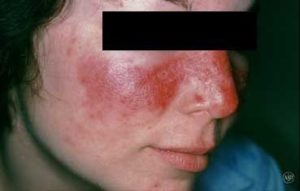 Lupus is a systemic autoimmune disorder that causes the body’s immune system to attack tissues and organs. Inflammation from lupus affects joints, skin, kidneys, brain, heart, and lungs. When lupus affects the epidermis, it is known as cutaneous lupus erythematosus.
Lupus is a systemic autoimmune disorder that causes the body’s immune system to attack tissues and organs. Inflammation from lupus affects joints, skin, kidneys, brain, heart, and lungs. When lupus affects the epidermis, it is known as cutaneous lupus erythematosus.
Types of cutaneous lupus.
Cutaneous lupus erythematosus causes rashes or sores on areas where sun exposure on areas such as the face, neck, arm, and legs. There are three different types of skin lupus.
Discoid Lupus
- Discoid Lupus is a chronic disease where disc-shaped lesions are found on areas such as the scalp and face mainly but can appear elsewhere on the body. These lesions can be painful and sore. Red, scaly and thick lesions can also develop as well. The lesions can change in color over time and can cause scarring. The disease can cause hair loss from the scalp and it may be permanent if scarring is evident around the scalp. Cancer can develop in discoid lupus over a length of time. The disease is photosensitive (an allergic reaction towards natural or artificial lighting).
Subacute Cutaneous Lupus
- Commonly known as SCL. Lesions on the skin can appear red and scaly either in a ring-shaped or have distinct edges. Lesions do not normally itch or scar but discoloration can appear over time. Areas such as arms, neck, and shoulders are commonly affected. SLC is photosensitive as well.
Acute Cutaneous Lupus
- This condition occurs when systemic lupus is active. A rash known as the “butterfly rash” is spreading across the cheeks and nose bridge forming a shape of a butterfly. The rash appears similarly as a sunburn but does not cause any pain or scarring and can become discolored over time. Other areas can be affected as well such as the arms or legs.
The cause of lupus is unknown but certain factors can trigger an autoimmune response such as sunlight where exposure to areas of the outbreak can cause serious skin lesions, infections due to the compromised immune system and certain medications like blood pressure or antibiotics can induce an autoimmunological response.
Risk factors include sex where lupus is more commonly diagnosed in women than men, ages 15-45 are often diagnosed as well as race. African-Americans, Asians, and Hispanics are more likely to be diagnosed with lupus.
Here at the Center for Dermatology, Laser and Cosmetic Surgery, Dr. Farber has over 30 years of experience helping patients managed their symptoms to lead a better and healthier lifestyle. Dr. Farber is always up to date on the latest medical treatments for the disease leaving our patients feeling reassured that they can go on and live a better quality of life they deserve.
If you or someone you know may have lupus, call us at Center for Dermatology, Laser and Cosmetic Surgery for an appointment with Dr. Farber.
Philadelphia Main Line, Office
Center for Dermatology, Laser, and Cosmetic Surgery
915 Montgomery Avenue
Suite 204
Narberth, PA 19072
Phone: 610-664-4433
North East Philadelphia Office
Center for Dermatology, Laser, and Cosmetic Surgery
9892 Bustleton Avenue
Suite 204
Philadelphia, PA 19115
Phone: 215-676-2464



